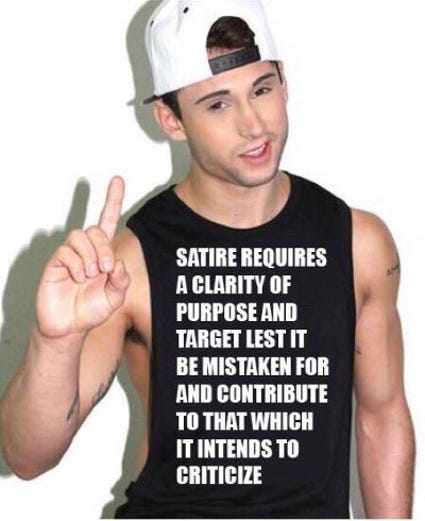I Am Angry at Work Funny
How to Write 'Funny Anger' (Not 'Angry Anger')
Why humor editors love the former and reject the latter

As a comedian and editor for The Belladonna, a popular humor publication on Medium, I read and write a lot of angry humor pieces. But for every terrific piece of satire, I read at least 4–5 attempts that fall flat. Why? Because they aren't funny.
One of the best ways humor writers can improve their chances with a publication is to learn how to turn a furious, humorless rant into a thoughtful, deliberate piece with witty, razor-sharp timing.
These are the guidelines I follow in my own satire writing and what I keep in mind as an editor:
Anger on its own isn't funny
Satire is a genre of humor that critiques systems and speaks truth to power. Although satire is often described as "the comedy of rage," too many writers mistakenly believe that a long, angry rant = satire. While that can be true, rage on its own is not funny anger; it's just angry anger.
What is funny anger?
Satire that successfully employs funny anger begins with a simple premise: "I'm angry about some perceived problem, issue, slight, or curious behavior." It then injects humor to bring readers onto the author's side.
Take Wendy Molyneux's viral McSweeney's piece, Oh My Fucking God, Get the Fucking Vaccine Already, You Fucking Fucks:
"The fucking vaccine will not make you magnetic. Are you fucking kidding me? It just fucking won't. That's not even a fucking thing, and that lady who tried to pretend the vaccine made her fucking magnetic looked like a real fucking fuckwad and a fucking idiot, so get fucking vaccinated. Jesus. Fuck."
This piece works because not only is Molyneux's rage visceral and deeply relatable, but she also expertly uses hyperbole, repetition, and comedic timing to deliver laughs.
Bottom line: good satire comes across as funny anger (a humorous deconstruction), as opposed to angry anger (a florid rant).
What is angry anger?
It's just an angry rant, devoid of any humor. It's the difference between a first draft of angry word vomit and a second, third, or fourth draft with actual jokes in place of unhinged tangents, and clever wordplay in place of ill-conceived cursing and insults.
Curse words on their own are angry anger, not satire. Cursing in successful satire must heighten the other humor in the piece or speak to a greater satirical point, like in George Carlin's 7 Words You Can't Say On TV.
"But Alice," you say, "humor is subjective! I think angry tirades and cursing are funny."
Cool! I'm absolutely not telling you what to laugh at. I'm just saying it's not satire — or even generally recognized as comedy — and most humor editors will reject a piece that doesn't have humor and jokes built into it.
What is punching down?
A subset of angry anger is "punching down" — mean-spirited comedy in which someone's identity is the punchline. Racism, sexism, ableism, homophobia, transphobia, Islamophobia, etc.? None of this is satire.

One caveat: some excellent satire can use hateful language if AND ONLY IF it is delivered with the specific intention of criticizing those hateful beliefs. For example, see Carlos Greaves' McSweeney's piece As a Republican, I Believe White Men Are Boys, Boys of Color Are Men, and Underage Girls Are Consenting Adults. Irony is a great satirical tool for critiquing the hypocrisy of those in power, and seasoned humorists like Greaves know when and how to use that tool for maximum effect.
In the words of a Tumblr user who accidentally wrote a now-famous fake Terry Pratchett quote:
"Satire is meant to ridicule power. If you are laughing at people who are hurting, it's not satire; it's bullying."
Additional resources:
- The Belladonna Editors Explain: Punching Up vs. Punching Down in The Belladonna Comedy Newsletter
- Every Joke Falls in One of 11 Categories, Says Founding Editor of The Onion (Big Think)
Have a strong satirical point of view
Overwhelmingly, satire is most effective when authors consider the following questions:
- Who or what is my satirical target?
- Why do I feel so strongly about this topic?
- Who is my intended audience?
- What do I hope to accomplish with this piece?
- How can I make this topic funny without punching down?
Planning your piece and writing from a bit of a remove allows the humor to shine through even the most biting satire. This is where lists come in.
Write 3 lists
Writing a list is the most straightforward way to generate ideas for a satire piece. Comedy institutions like The Second City teach this method, and you can tweak it to fit your style. I use my own version of this process when I get stuck:
- Heckles: List 10–15ish topics that make you angry: a topical news story, work frustrations, relationship problems — whatever you want.
- Hahas: Pick a few topics from the Heckles list that might make for a good piece of satire. On a new page, list as many jokes as you can think of for each Heckle (optional: set a timer for 5 minutes). "Jokes" can be actual setups + punchlines, amusing observations, analogies, or anything else about the topic that has the potential to be funny. This page will never see the light of day, so take risks with your jokes. Experiment with irony and hyperbole, make silly observations, do whatever you want without fear that someone will see this list and judge you for it.
- Humor Delivery Method: Look at the first two lists and see what topics and jokes speak to you. On a new page, make a list of 5–10 formats/styles that will best deliver your satirical point of view to readers. Monologues, letters, petitions, to do lists, quizzes… the options are endless. But the format and topic should make sense together and allow you to deliver lots of jokes very quickly with as little setup as possible.
Example #1: When Rush Limbaugh died, I knew some bozo at The New York Times would eventually publish an opinion column chastising all the people celebrating Limbaugh's death (I was right). So I wrote an op-ed piece from the POV of the The Gotham Times Editorial Board:
Example #2: When restaurant owners began complaining about the labor shortage, I thought of all the reasons I'll never return to the service industry, turned them into jokes, and created a BINGO card:
Additional resources:
- What to Do When You Have a Great Title for a Humor Piece (and Nothing Else) by Sarah James
- How to Write Satire and Humor by Alex Baia
Determine where you fall on the "Rage-O-Meter"
Senses of humor can fall anywhere on the Rage-O-Meter, which is a thing I just made up (but it's fairly intuitive).
Not all anger meets the level of rage, and satire doesn't require readers to be just as angry about the topic as the author. There exists a whole world of apathetic-leaning people who I do not understand, because I fall on the opposite end of the Rage-O-Meter: almost any person, place, and thing has the potential to make me incandescently irate. If I'm not actively angry, I'm usually at least mildly irked.

Figure out if you're the kind of person who threatens to walk into the ocean at the slightest inconvenience (me), or if you save your anger for something objectively more worthy (healthier people).
Now it's time to answer the big question: would you prefer to write a humor piece that complains, critiques, or both?
Complaint vs. critique
Some anger resonates with audiences because it's cathartic, and the release of laughter helps readers relax and lean into a premise. Then the author builds and rebuilds tension through exploring different avenues of rage — throwing in small humorous asides along the way — until the next big tension-relieving laugh line, and the cycle repeats. The best example of this kind of anger in satire is The Onion's 9/11 issue.
"If you're trying to change someone's mind with your satire, coming at it in a combative way might make them put their guard up. But coming at it with humor gives them a chance to consider what you're saying."
— The Belladonna Editors Explain: "Angry Anger" vs. "Satire Anger" in The Belladonna Comedy Newsletter
Other anger lures readers into the author's deranged cave of bizarre and deeply-held irritants:
- Seinfeld and Curb Your Enthusiasm are built on petty grievances. (I'd argue that while irrational complaints are foundational for each show, Curb Your Enthusiasm also successfully critiques societal problems that anger both character-Larry and real person-Larry.)
- Honest Product Reviews: This $2000 Goddamn Vetements Hoodie by Kristen Pyszczyk
- John Oliver's rant about The Da Vinci Code
And then there's the weird sort of resigned anger that's so pathetic it's funny, like Eeyore, Droopy Dog, and Debbie Downer.
Satire that successfully employs funny anger in any form is an absolute joy to read, and humor editors love receiving these submissions.
Keep this in mind when you submit your work
Rejection is inevitable in humor writing, and that's OK! Sometimes good pieces are rejected because they just aren't what the editor is looking for at that time. However, reading a publication's submission guidelines before submitting will hugely increase your likelihood of acceptance.
Brevity is the soul of wit. Get in, make your point, tell your jokes, and get out. A good editor will know when you've gone too far and either pull you back or pass on the piece altogether.
Editors want to accept good, interesting writing, so don't be afraid to take big swings!
"I think when you're in the pure creative imagination stage of writing, it should just be about 'what is the funniest thing that could happen next' or 'what's the most interesting thing that could happen next' without regard for practical matters just yet."
— Nate Dern (interviewed by Alex Baia in How to Write Comedy for All Occasions )
Additional resources:
- Your Humor Piece Needs Way Less Explanation Than You Think It Does by Sarah James
- Top 10 Short Humor Writing Mistakes: Advice From an Editor by Alex Baia
- 20 Markets That Publish Humor Writing by Julie Vick
Source: https://writingcooperative.com/how-to-write-funny-anger-not-angry-anger-27a6fb13d66a
0 Response to "I Am Angry at Work Funny"
Post a Comment